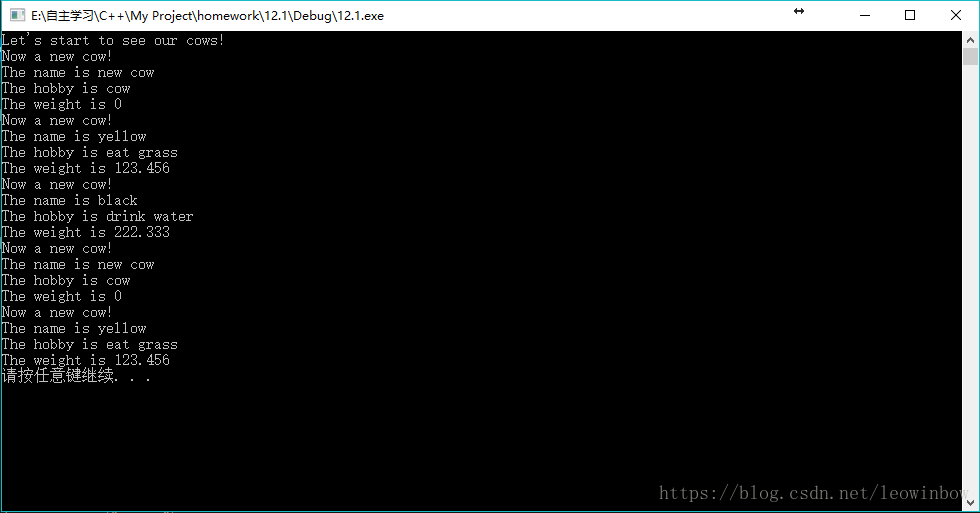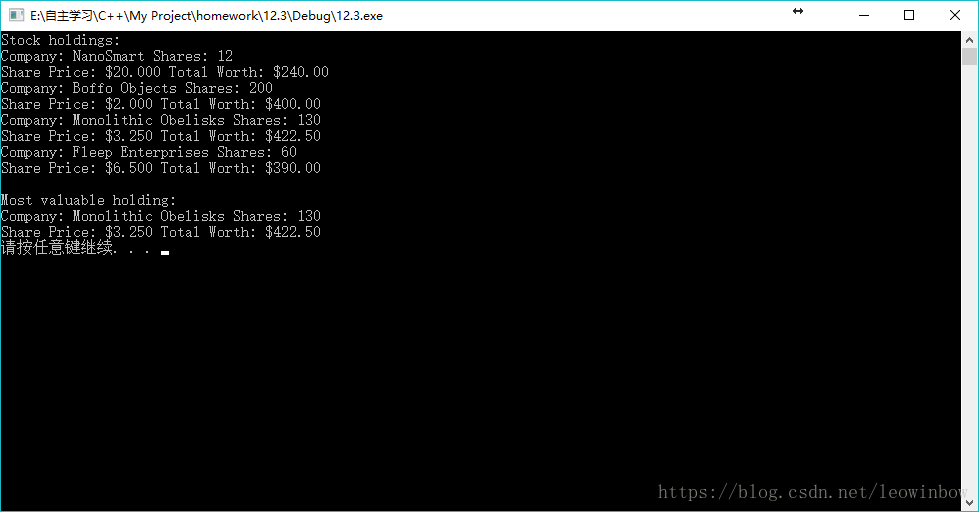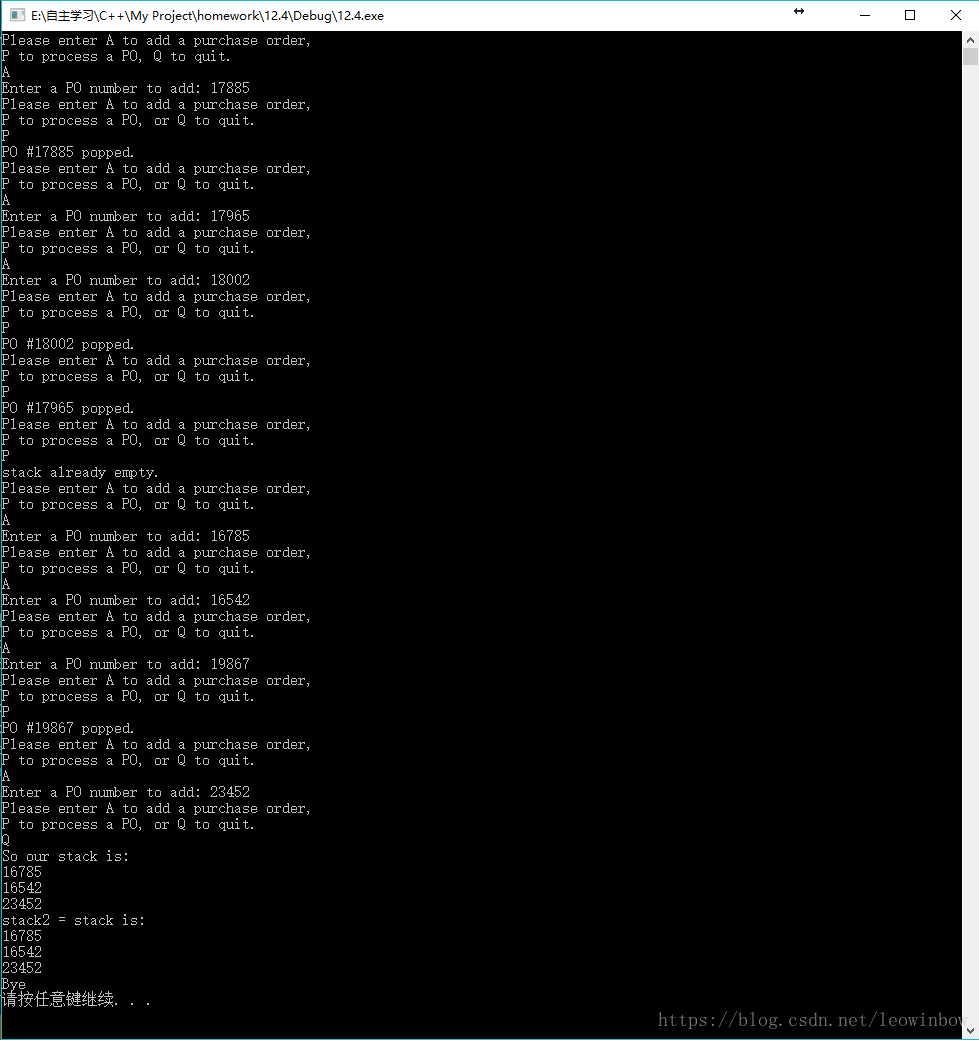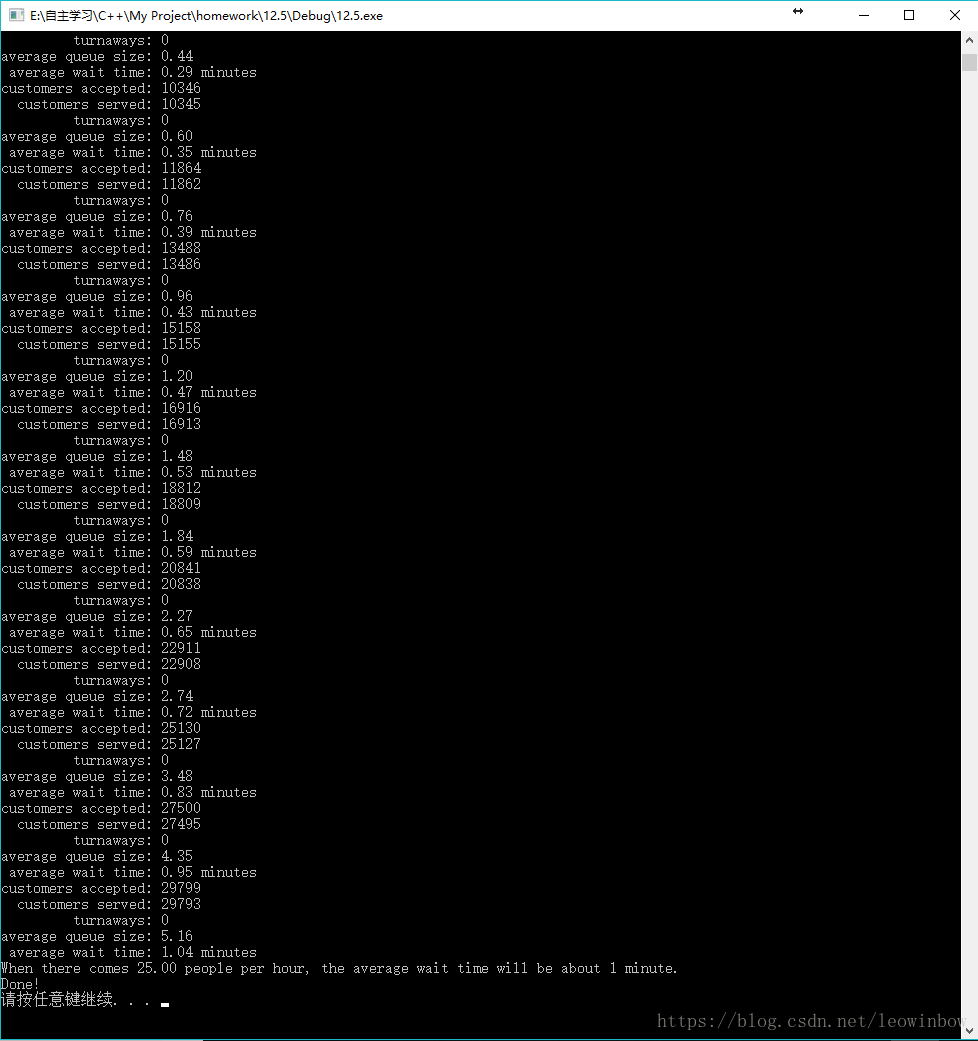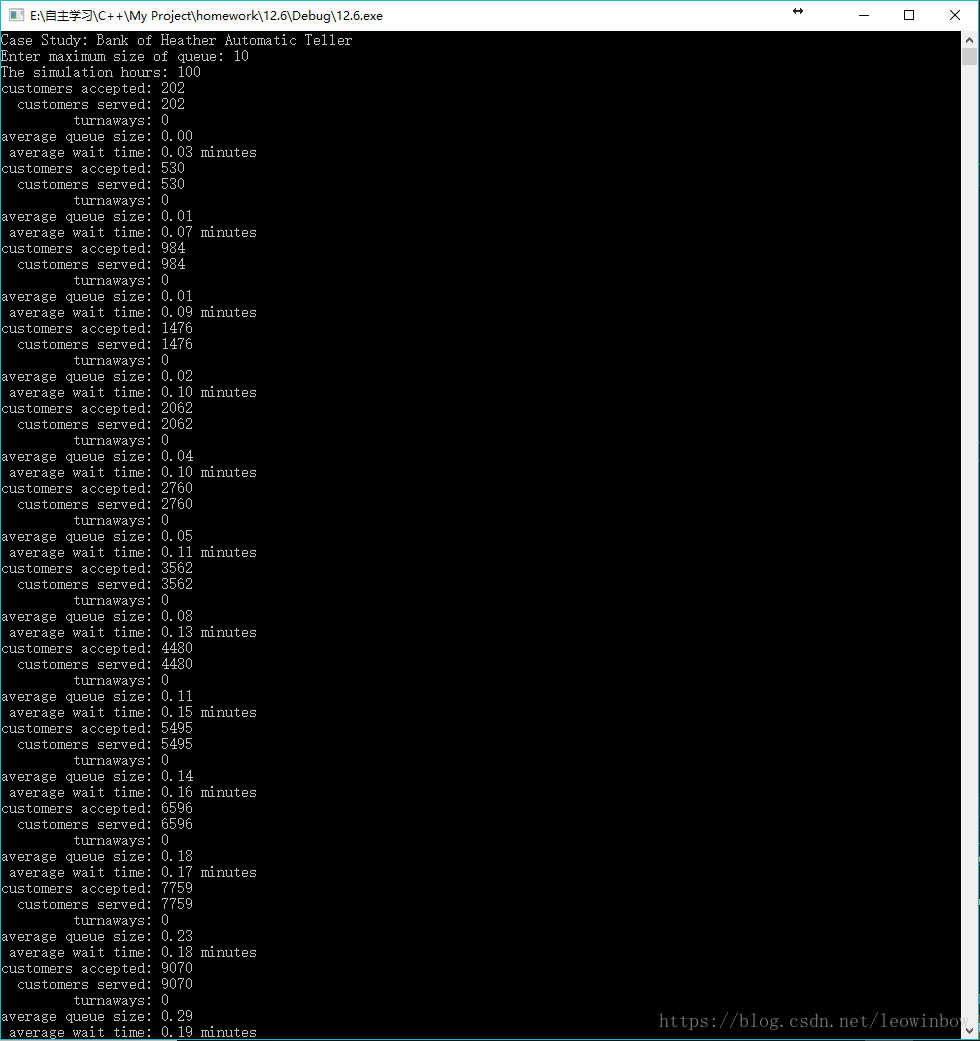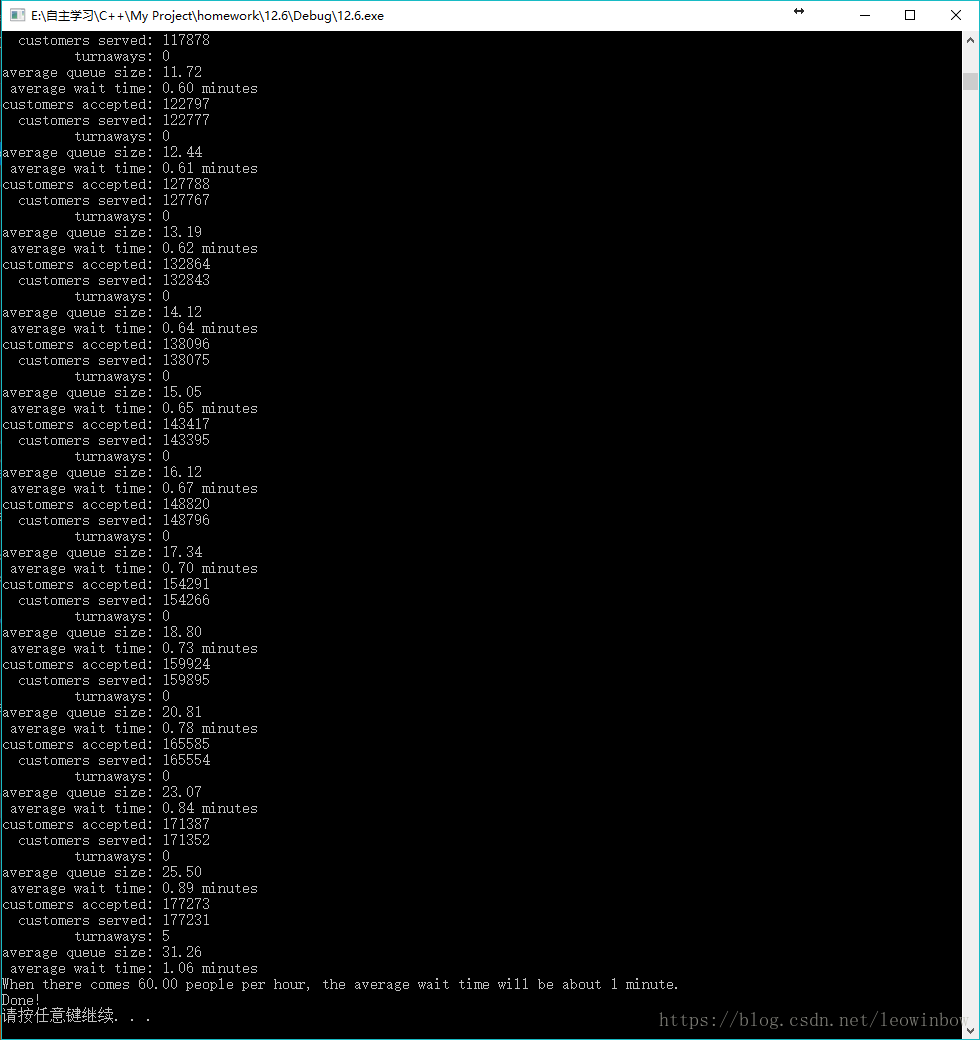C++ Primer Plus(第六版)编程练习答案 第12章 类和动态内存分配
本章所有编程练习的工程源码可在此处下载(点击此链接下载),供大家参考交流!
1. 对于下面的类声明:
class Cow {
char name[20];
char *hobby;
double weight;
public:
Cow();
Cow(const char * nm, const char * ho, double wt);
Cow(const Cow c&);
~Cow();
Cow & operator=(const Cow & c);
void ShowCow() const; // display all new data
};
给这个类提供实现,并编写一个使用所有成员函数的小程序。
对于本题,首先题中已经给出了类声明,所以头文件不需要自己定义,可以直接使。
所以头文件cow.h代码如下:
// cow.h -- head file
#ifndef COW_H_
#define COW_H_
class Cow
{
private:
char name[20];
char * hobby;
double weight;
public:
Cow();
Cow(const char * nm, const char * ho, double wt);
Cow(const Cow & c);
~Cow();
Cow & operator=(const Cow & c);
void ShowCow() const;
};
#endif在这里,我们之所以在书中提供的类声明的前后加上#ifndef, #define, #endif主要是为了防止该.h文件被重复引用。详情请点击本链接查看。
声明了头文件之后,我们首先要考虑去定义头文件中的函数声明。
头文件的私有成员变量中有字符串数组和字符串指针,因此需要用到strcpy_s函数,所以头文件中需要包含
另外,在重载运算符=时,需要在一开始delete一下,以防止此时this指针的hobby变量储存的地址是被分配使用过的。
所以实现文件cow.cpp代码如下:
// cow.cpp -- containing the functions' definition
#include "stdafx.h"
#include
#include
#include "cow.h"
using std::cout;
using std::endl;
Cow::Cow()
{
strcpy_s(name, 20, "new cow");
hobby = new char[4];
strcpy_s(hobby, 4, "cow");
weight = 0.0;
}
Cow::Cow(const char * nm, const char * ho, double wt)
{
weight = wt;
hobby = new char[strlen(ho) + 1];
strcpy_s(hobby, strlen(ho)+1, ho);
strcpy_s(name, 20, nm);
}
Cow::Cow(const Cow & c)
{
strcpy_s(name, 20, c.name);
hobby = new char[strlen(c.hobby) + 1];
strcpy_s(hobby, strlen(c.hobby) + 1, c.hobby);
weight = c.weight;
}
Cow::~Cow()
{
delete[] hobby;
}
Cow & Cow::operator=(const Cow & c)
{
delete[] hobby;
hobby = new char[strlen(c.hobby) + 1];
strcpy_s(hobby, strlen(c.hobby) + 1, c.hobby);
weight = c.weight;
strcpy_s(name, 20, c.name);
return *this;
}
void Cow::ShowCow() const
{
cout << "Now a new cow!\n";
cout << "The name is " << name << endl;
cout << "The hobby is " << hobby << endl;
cout << "The weight is " << weight << endl;
} 接下来我们来考虑如何使用这些成员函数组成检验文件。
其实本题的文件的主要功能只有3个,各种方式的函数初始化,使用重载的运算符=,使用ShowCow函数进行显示。
检验文件checkcow.cpp代码如下:
// checkcow.cpp -- check all the functions
#include "stdafx.h"
#include
#include "cow.h"
using namespace std;
int main()
{
cout << "Let's start to see our cows!\n";
Cow c1;
c1.ShowCow();
Cow c2("yellow", "eat grass", 123.456);
c2.ShowCow();
Cow c3("black", "drink water", 222.333);
c3.ShowCow();
c3 = c1;
Cow c4(c2);
c3.ShowCow();
c4.ShowCow();
system("pause");
return 0;
} 运行结果如下图所示:
2. 通过完成下面的工作来改进String类声明(即将String1.h升级为String2.h)。
a. 对+运算符进行重载,使之可将两个字符串合并成1个。
b. 提供一个Stringlow()成员函数,将字符串中所有的字母字符转换为小写(别忘了cctype系列字符函数)。
c. 提供String()成员函数,将字符串中所有字母字符转换成大写。
d. 提供一个这样的成员函数,它接受一个char参数,返回该字符在字符串中出现的次数。
使用下面的程序来测试您的工作:
(……代码忽略……)
输出应与下面相似:
(……代码忽略……)
本题是在String1.h的基础上进行升级,添加几项功能再测试。
首先,需要重载+运算符,将两个字符串合并成1个,这里看起来只需要添加一个成员函数,其实不然。由于检验文件中既有将string对象相加,又有将字符串指针相加,还存在将string对象和字符串指针相加的情况,所以我们需要对应的定义3个函数来分别重载这三种情况下的+运算符。
其次,提供两个函数将字符串中的所有字母字符转换为小写或大写,这个功能使用
最后,提供一个成员函数,接受一个char参数,返回该参数在字符串中出现的次数,该函数将需要遍历整个字符串进行计数。
对于头文件,我们只需要添加以上6个函数即可,所以头文件string2.h代码如下:
// string2.h -- fixed and augmented string class definition
#ifndef STRING2_H_
#define STRING2_H_
#include
using std::ostream;
using std::istream;
class String
{
private:
char * str;
int len;
static int num_strings;
static const int CINLIM = 80;
public:
String(const char * s);
String();
String(const String &);
~String();
int length() const { return len; }
void stringlow();
void stringup();
int has(char x);
String & operator=(const String &);
String & operator=(const char *);
char & operator[] (int i);
const char & operator[] (int i) const;
friend bool operator<(const String &st1, const String &st2);
friend bool operator>(const String &st1, const String &st2);
friend bool operator==(const String &st, const String &st2);
friend ostream & operator<<(ostream & os, const String &st);
friend istream & operator>>(istream & is, String & st);
static int HowMany();
String operator+(const String &) const;
String operator+(const char *) const;
friend String operator+(const char *, const String &);
}; 对于实现文件,其他的功能可以沿用string1.cpp,新添加的几个函数需要自定义。
首先,对于重载+运算符,我们分为三个函数。第一个是两个string对象之间的加法,在这里呢,我们可以使用strcat_s函数,直接将两个string对象进行拼接,但是由于默认情况下string对象的最后一个字符都是'\0',所以处理起来比较麻烦,我选择依然使用strcpy_s函数,只是复制的地址不一样,比如说str1的长度为10,str2的长度为10,我们新定义一个str3,要想把str1的内容和str2的内容加起来放进str3中,就把str1的内容从str3的第一个字符处开始赋值,把str2的内容从str3的第11个字符处开始赋值,这样就可以了。对于字符串指针变量的情况,可以完全类似处理。对于字符串指针变量和string对象相加的情况,我们可以人为地进行强制类型转换,将字符串指针变量转换为string对象,再加,那么此时相加就会调用前面定义的两个string对象相加的函数,即可以完成任务。
其次,我们在实现文件中包含头文件
最后,我们需要定义has()函数。该函数遍历整个字符串,然后识别输入的特定char类型变量,然后计数。我们在for循环内部嵌套一个if条件判断即可。
实现文件string2.cpp代码如下所示:
// string2.cpp -- String class methods
//
#include "stdafx.h"
#include
#include "string2.h"
#include
using std::cin;
using std::cout;
int String::num_strings = 0;
int String::HowMany()
{
return num_strings;
}
String::String(const char * s)
{
len = std::strlen(s);
str = new char[len + 1];
strcpy_s(str, std::strlen(s) + 1, s);
num_strings++;
}
String::String()
{
len = 4;
str = new char[1];
str[0] = '\0';
num_strings++;
}
String::String(const String & st)
{
num_strings++;
len = st.len;
str = new char[len + 1];
strcpy_s(str, std::strlen(st.str) + 1, st.str);
}
String::~String()
{
--num_strings;
delete[] str;
}
void String::stringlow()
{
for (int i = 0; i < this->len + 1; i++)
{
this->str[i] = tolower(this->str[i]);
}
}
void String::stringup()
{
for (int i = 0; i < this->len + 1; i++)
{
this->str[i] = toupper(this->str[i]);
}
}
int String::has(char x)
{
int count = 0;
for (int i = 0; i < this->len + 1; i++)
{
if (this->str[i] == x)
count++;
}
return count;
}
String & String::operator=(const String & st)
{
if (this == &st)
return *this;
delete[] str;
len = st.len;
str = new char[len + 1];
strcpy_s(str, std::strlen(st.str) + 1, st.str);
return *this;
}
String & String::operator=(const char * s)
{
delete[] str;
len = std::strlen(s);
str = new char[len + 1];
strcpy_s(str, std::strlen(s) + 1, s);
return *this;
}
char & String::operator[] (int i)
{
return str[i];
}
const char & String::operator[] (int i) const
{
return str[i];
}
bool operator<(const String &st1, const String &st2)
{
return (std::strcmp(st1.str, st2.str) < 0);
}
bool operator>(const String &st1, const String &st2)
{
return st2 < st1;
}
bool operator==(const String &st1, const String &st2)
{
return (std::strcmp(st1.str, st2.str) == 0);
}
ostream & operator<<(ostream & os, const String & st)
{
os << st.str;
return os;
}
istream & operator>>(istream & is, String & st)
{
char temp[String::CINLIM];
is.get(temp, String::CINLIM);
if (is)
st = temp;
while (is &&is.get() != '\n')
continue;
return is;
}
String String::operator+(const String & st) const
{
int total_len = len + st.len;
char *temp = new char[total_len + 1];
strcpy_s(temp, len + 1, str);
strcpy_s(temp + len, st.len + 1, st.str);
temp[total_len] = '\0';
return String(temp);
}
String String::operator+(const char * s) const
{
int total_len = len + strlen(s);
char *temp = new char[total_len + 1];
strcpy_s(temp, len + 1, str);
strcpy_s(temp + len, std::strlen(s) + 1,s);
temp[total_len] = '\0';
return String(temp);
}
String operator+(const char * s, const String & st)
{
return String(s) + st;
} 检验文件题中直接给出,saying2.cpp代码如下所示:
// saying1.cpp -- using expanded String class
#include "stdafx.h"
#include
#include "string2.h"
using namespace std;
int main()
{
String s1(" and I am a C++ student.");
String s2 = "Please enter your name: ";
String s3;
cout << s2;
cin >> s3;
s2 = "My name is " + s3;
cout << s2 << ".\n";
s2 = s2 + s1;
s2.stringup();
cout << "The string\n" << s2 << "\ncontains " << s2.has('A') << " 'A' characters in it.\n";
s1 = "red";
String rgb[3] = { String(s1), String("green"), String("blue") };
cout << "Enter the name of a primary color for mixing light: ";
String ans;
bool success = false;
while (cin >> ans)
{
ans.stringlow();
for (int i = 0; i < 3; i++)
{
if (ans == rgb[i])
{
cout << "That's right!\n";
success = true;
break;
}
}
if (success)
break;
else
cout << "Try again!\n";
}
cout << "Bye\n";
system("pause");
return 0;
} 运行结果如下图所示:
从运行结果可以看出,该检验文件完成的功能和预期完全一致。
3. 新编写程序清单10.7和程序清单10.8描述的Stock类,使之使用动态内存分配的内存,而不是string类对象来存储股票名称。另外,使用重载的operator<<()定义代替show()成员函数。再使用程序清单10.9测试新的定义程序。
本题要求将Stock类进行修改,使用动态内存分配代替string类对象,所以string对象company必须改为char *类型,然后去掉show()函数,改为使用重载的operator<<()来进行输出,该函数我们选择使用友元。
所以头文件stock20.h代码如下:
// stock20.h -- augmented version
#ifndef STOCK20_H_
#define STOCK20_H_
#include
using std::ostream;
class Stock
{
private:
char * company;
int shares;
double share_val;
double total_val;
void set_tot() { total_val = shares * share_val; }
public:
Stock();
Stock(const char * co, long n = 0, double pr = 0.0);
~Stock();
void buy(long num, double price);
void sell(long num, double price);
void update(double price);
friend ostream & operator<<(ostream & os, const Stock &st);
const Stock & topval(const Stock & s) const;
};
#endif
对于实现文件,当company变量从string对象变成char *类型之后,构造函数那里就必须要改变,必须使用new来动态分配它的内存,而且析构函数必须要delete。对于重载的<<运算符,我们也按照原来的show()函数一样的格式,对ios_base里面的处理不变,只是在此之后,按照标准的重载<<运算符的方式进行输出,同时将cout完全换成我们的输出os。
实现文件stock20.cpp代码如下:
// stock20.cpp -- augnented version
#include "stdafx.h"
#include
#include "stock20.h"
using std::ostream;
Stock::Stock()
{
company = new char[std::strlen("no name") + 1];
strcpy_s(company, std::strlen("no name") + 1, "no name");
shares = 0;
share_val = 0.0;
total_val = 0.0;
}
Stock::Stock(const char * co, long n, double pr)
{
company = new char[std::strlen(co) + 1];
strcpy_s(company, std::strlen(co) + 1, co);
if (n < 0)
{
std::cout << "Number of shares can't be negative; " << company << " shares set to 0.\n";
shares = 0;
}
else
shares = n;
share_val = pr;
set_tot();
}
Stock::~Stock()
{
delete[] company;
}
void Stock::buy(long num, double price)
{
if (num < 0)
{
std::cout << "Number of shares purchased can't be negative. " << "Transaction is aborted.\n";
}
else
{
shares += num;
share_val = price;
set_tot();
}
}
void Stock::sell(long num, double price)
{
using std::cout;
if (num < 0)
{
cout << "Number of shares sold can't be negative. " << "Transaction is aborted.\n";
}
else if (num > shares)
{
cout << "You can't sell more than you have! " << "Transaction is aborted.\n";
}
else
{
shares -= num;
share_val = price;
set_tot();
}
}
void Stock::update(double price)
{
share_val = price;
set_tot();
}
ostream & operator<<(ostream & os, const Stock &st)
{
using std::ios_base;
ios_base::fmtflags orig = os.setf(ios_base::fixed, ios_base::floatfield);
std::streamsize prec = os.precision(3);
os << "Company: " << st.company << " Shares: " < total_val)
return s;
else
return *this;
}
检验文件题目要求直接使用程序清单10.9,所以usestock20.cpp代码如下:
// usestock20.cpp -- using the Stock class
// compile with stock20.cpp
#include "stdafx.h"
#include
#include "stock20.h"
using std::cout;
const int STKS = 4;
int main()
{
Stock stocks[STKS] =
{
Stock("NanoSmart", 12, 20.0),
Stock("Boffo Objects", 200, 2.0),
Stock("Monolithic Obelisks", 130, 3.25),
Stock("Fleep Enterprises", 60, 6.5)
};
std::cout << "Stock holdings:\n";
int st;
for (st = 0; st < STKS; st++)
cout << stocks[st];
const Stock * top = &stocks[0];
for (st = 1; st < STKS; st++)
top = &top->topval(stocks[st]);
cout << "\nMost valuable holding:\n";
cout << *top;
system("pause");
return 0;
} 运行结果如下图所示:
4. 请看下面程序清单10.10定义的Stack类的变量:
(……代码忽略……)
正如私有成员表明的,这个类使用动态内存分配的数组来保存栈项。请重新编写方法,以适应这种新的表示法,并编写一个程序来演示所有的方法,包括复制构造函数和赋值运算符。
本题提供了头文件代码,需要注意的地方在于,本题的私有成员中,定义了一个无符号long类型的指针,对于这种类型的变量,我们同样需要使用new来动态分配内存。
头文件stack.h代码如下:
// stack.h -- class declaration for the stack ADT
#include
using std::ostream;
typedef unsigned long Item;
class Stack
{
private:
enum { MAX = 10 };
Item * pitems;
int size;
int top;
public:
Stack(int n = MAX);
Stack(const Stack & st);
~Stack();
bool isempty() const;
bool isfull() const;
bool push(const Item & item);
bool pop(Item & item);
Stack & operator=(const Stack & st);
friend ostream & operator<<(ostream & os, const Stack &st);
};
对于实现文件,大部分内容我们可以参考程序清单10.11,而新增的size变量和修改过的pitems对象,我们需要单独编写,且要注意pitems对象必须使用new来动态分配内存,析构函数里面必须将其delete,另外在赋值运算符进行重载时,必须首先将pitems对象进行delete,以防止它的内存已经被占用。
另外我们需要额外编写赋值构造函数,因为要防止初始化时默认构造函数产生二义性;还需要重载<<运算符用来输出。
实现文件stack.cpp代码如下:
// stack.cpp -- functions' definition
#include "stdafx.h"
#include
using std::endl;
#include "stack.h"
Stack::Stack(int n)
{
pitems = new Item[n];
for (int i = 0; i < n; i++)
{
pitems[i] = 0;
}
top = 0;
size = n;
}
Stack::Stack(const Stack & st)
{
pitems = new Item[st.size];
for (int i = 0; i < st.size; i++)
{
pitems[i] = st.pitems[i];
}
top = st.top;
size = st.size;
}
Stack::~Stack()
{
delete[] pitems;
}
bool Stack::isempty() const
{
return top == 0;
}
bool Stack::isfull() const
{
return top == MAX;
}
bool Stack::push(const Item & item)
{
if (top < MAX)
{
pitems[top++] = item;
return true;
}
else
return false;
}
bool Stack::pop(Item & item)
{
if (top > 0)
{
item = pitems[--top];
return true;
}
else
return false;
}
Stack & Stack::operator=(const Stack & st)
{
if (this == &st)
return *this;
delete[] pitems;
top = st.top;
size = st.size;
pitems = new Item[st.size];
for (int i = 0; i < st.size; i++)
{
pitems[i] = st.pitems[i];
}
return *this;
}
ostream & operator<<(ostream & os, const Stack & st)
{
for (int i = 0; i < st.top; i++)
{
os << st.pitems[i] << endl;
}
return os;
} 接下来我们可以在程序清单10.12的基础上进行少量修改,就可以检验上面编写的类方法了。对于检验栈是否为空和是否为满,以及入栈出栈,我们都可以完全参考程序清单10.12,下面我们主要检验新的功能,包括使用复制构造函数进行赋值,使用重载的=运算符和<<运算符。
检验文件usestack.cpp代码如下:
// usestack.cpp -- tetsing the Stack class
#include "stdafx.h"
#include
#include
#include "stack.h"
int main()
{
using namespace std;
Stack st;
char ch;
unsigned long po;
cout << "Please enter A to add a purchase order,\n" << "P to process a PO, Q to quit.\n";
while (cin >> ch && toupper(ch) != 'Q')
{
while (cin.get() != '\n')
continue;
if (!isalpha(ch))
{
cout << '\a';
continue;
}
switch (ch)
{
case 'A':
case 'a': cout << "Enter a PO number to add: ";
cin >> po;
if (st.isfull())
cout << "stack already full.\n";
else
st.push(po);
break;
case 'p':
case 'P': if (st.isempty())
cout << "stack already empty.\n";
else
{
st.pop(po);
cout << "PO #" << po << " popped.\n";
}
break;
}
cout << "Please enter A to add a purchase order,\n" << "P to process a PO, or Q to quit.\n";
}
cout << "So our stack is:\n" << st;
Stack st2;
st2 = st;
cout << "stack2 = stack is:\n" << st2;
cout << "Bye\n";
system("pause");
return 0;
} 运行结果如下图所示:
从结果图可以看出,我们首先检验了一下程序清单10.12检验的功能,都可以正确运行,接下来我们对栈内数据进行了填充,然后进行了复制构造函数式赋值,以及=运算符赋值,都是正确的。
5. Heather银行进行的研究表明,ATM客户不希望排队时间不超过1分钟。使用程序清单12.10中的模拟,找出要使平均等候时间为1分钟,每小时到达的客户数应为多少(试验时间不短于100小时)?
首先,我个人认为本题的所谓不希望排队时间不超过1分钟是写错了,应该是不希望排队时间超过1分钟,后面的代码也都是基于这个假设写的。
其次,由于本题涉及的功能完全是程序清单12.10头文件和程序清单12.11实现文件可以完成的,所以头文件我们不需要修改,直接使用即可。
所以头文件queue.h代码如下:
// queue.h -- interface for a queue
#ifndef QUEUE_H_
#define QUEUE_H_
class Customer
{
private:
long arrive;
int processtime;
public:
Customer()
{
arrive = processtime = 0;
}
void set(long when);
long when() const
{
return arrive;
}
int ptime() const
{
return processtime;
}
};
typedef Customer Item;
class Queue
{
private:
struct Node
{
Item item;
struct Node * next;
};
enum { Q_SIZE = 10 };
Node * front;
Node * rear;
int items;
const int qsize;
Queue(const Queue & q) : qsize(0) { }
Queue & operator=(const Queue & q)
{
return *this;
}
public:
Queue(int qs = Q_SIZE);
~Queue();
bool isempty() const;
bool isfull() const;
int queuecount() const;
bool enqueue(const Item &item);
bool dequeue(Item &item);
};
#endif实现文件queue.cpp代码如下:
// queue.cpp -- Queue and Customer methods
#include "stdafx.h"
#include "queue.h"
#include
Queue::Queue(int qs) : qsize(qs)
{
front = rear = NULL;
items = 0;
}
Queue::~Queue()
{
Node * temp;
while (front != NULL)
{
temp = front;
front = front->next;
delete temp;
}
}
bool Queue::isempty() const
{
return items == 0;
}
bool Queue::isfull() const
{
return items == qsize;
}
int Queue::queuecount() const
{
return items;
}
bool Queue::enqueue(const Item &item)
{
if (isfull())
return false;
Node * add = new Node;
add->item = item;
add->next = NULL;
items++;
if (front == NULL)
front = add;
else
rear->next = add;
rear = add;
return true;
}
bool Queue::dequeue(Item &item)
{
if (front == NULL)
return false;
item = front->item;
items--;
Node * temp = front;
front = front->next;
delete temp;
if (items == 0)
rear = NULL;
return true;
}
void Customer::set(long when)
{
processtime = std::rand() % 3 + 1;
arrive = when;
}
接下来主要需要修改的就是检验文件了。
首先呢,我们这里假设试验时间不短于100小时,为了简单起见,我就将试验时间定为100小时,接下来我们初始化perhour为1,再对perhour变量进行累加循环,即对每小时到达的客户数量进行累加循环;定义一个avetime变量,表示平均等候时间;使用while语句,判断条件为(perhour++ && avetime <= 1),即从每小时到达客户数为1开始,依次增加每小时到达的客户数,同时满足平均等候时间不超过1分钟,以此作为循环条件。再在循环内部去进行for循环操作。
这里需要注意的是,在for循环之前,我们需要先清空队列,这样才是真正的从完全为空开始进行试验,不然无法控制初始条件下队列中原来就存在的客户数量。
在for循环的最后,我们需要计算一下avetime,即将line_wait除以served。
具体详情请阅读代码,检验文件bank.cpp代码如下:
// bank.cpp -- using the Queue interface
// compile with queue.cpp
#include "stdafx.h"
#include
#include
#include
#include "queue.h"
const int MIN_PER_HR = 60;
bool newcustomer(double x);
int main()
{
using std::cin;
using std::cout;
using std::endl;
using std::ios_base;
std::srand(std::time(0));
cout << "Case Study: Bank of Heather Automatic Teller\n";
cout << "Enter maximum size of queue: ";
int qs;
cin >> qs;
Queue line(qs);
cout << "The simulation hours: 100\n";
int hours = 100;
long cyclelimit = MIN_PER_HR * hours;
double perhour;
double min_per_cust;
perhour = 1;
Item temp;
long turnaways = 0;
long customers = 0;
long served = 0;
long sum_line = 0;
int wait_time = 0;
long line_wait = 0;
double avetime = 0;
while (perhour++ && avetime <= 1)
{
while (!line.isempty())
{
line.dequeue(temp);
}
min_per_cust = MIN_PER_HR / perhour;
for (int cycle = 0; cycle < cyclelimit; cycle++)
{
if (newcustomer(min_per_cust))
{
if (line.isfull())
turnaways++;
else
{
customers++;
temp.set(cycle);
line.enqueue(temp);
}
}
if (wait_time <= 0 && !line.isempty())
{
line.dequeue(temp);
wait_time = temp.ptime();
line_wait += cycle - temp.when();
served++;
}
if (wait_time > 0)
wait_time--;
sum_line += line.queuecount();
}
if (customers > 0)
{
cout << "customers accepted: " << customers << endl;
cout << " customers served: " << served << endl;
cout << " turnaways: " << turnaways << endl;
cout << "average queue size: ";
cout.precision(2);
cout.setf(ios_base::fixed, ios_base::floatfield);
cout << (double)sum_line / cyclelimit << endl;
cout << " average wait time: " << (double)line_wait / served << " minutes\n";
}
else
cout << "No customers!\n";
avetime = (double)line_wait / served;
}
cout << "When there comes " << perhour << " people per hour, the average wait time will be about 1 minute.\n";
cout << "Done!\n";
system("pause");
return 0;
}
bool newcustomer(double x)
{
return (std::rand() * x / RAND_MAX < 1);
}
运行结果如下图所示:
在这里我输入的队列最大客户数是10,由于需要输出100组数据,所以我只截了开头和结尾,无法全部显示中间的细节结果。从最后的结果上来看,根据100小时的实验,当每小时到达客户数为25.00时,排队时间刚好不超过1分钟。
6. Heather银行想知道,如果再开设一台ATM,情况将如何。请对模拟进行修改,以包含两个队列。假设当第一台ATM前的排队人数少于第二台ATM时,客户将排在第一队,否则将排在第二队。然后再找出要使平均等候时间为1分钟,每小时到达的客户数应该为多少(注意,这是一个非线性问题,即将ATM数量加倍,并不能保证每小时处理的客户数量也翻倍,并确保客户等候的时间少于1分钟)?
本题要求多开设一个ATM,所以我们就会有两个队列,一起进行服务,客户到达之后的排队方式即是,如果第一台人数少于第二台,则排第一队,否则排第二队。所以在这里,头文件和实现文件依然不变,因为本质性功能依然没变。
所以头文件queue.h代码如下:
// queue.h -- interface for a queue
#ifndef QUEUE_H_
#define QUEUE_H_
class Customer
{
private:
long arrive;
int processtime;
public:
Customer()
{
arrive = processtime = 0;
}
void set(long when);
long when() const
{
return arrive;
}
int ptime() const
{
return processtime;
}
};
typedef Customer Item;
class Queue
{
private:
struct Node
{
Item item;
struct Node * next;
};
enum { Q_SIZE = 10 };
Node * front;
Node * rear;
int items;
const int qsize;
Queue(const Queue & q) : qsize(0) { }
Queue & operator=(const Queue & q)
{
return *this;
}
public:
Queue(int qs = Q_SIZE);
~Queue();
bool isempty() const;
bool isfull() const;
int queuecount() const;
bool enqueue(const Item &item);
bool dequeue(Item &item);
};
#endif实现文件queue.cpp代码如下:
// queue.cpp -- Queue and Customer methods
#include "stdafx.h"
#include "queue.h"
#include
Queue::Queue(int qs) : qsize(qs)
{
front = rear = NULL;
items = 0;
}
Queue::~Queue()
{
Node * temp;
while (front != NULL)
{
temp = front;
front = front->next;
delete temp;
}
}
bool Queue::isempty() const
{
return items == 0;
}
bool Queue::isfull() const
{
return items == qsize;
}
int Queue::queuecount() const
{
return items;
}
bool Queue::enqueue(const Item &item)
{
if (isfull())
return false;
Node * add = new Node;
add->item = item;
add->next = NULL;
items++;
if (front == NULL)
front = add;
else
rear->next = add;
rear = add;
return true;
}
bool Queue::dequeue(Item &item)
{
if (front == NULL)
return false;
item = front->item;
items--;
Node * temp = front;
front = front->next;
delete temp;
if (items == 0)
rear = NULL;
return true;
}
void Customer::set(long when)
{
processtime = std::rand() % 3 + 1;
arrive = when;
}
接下来我们着重修改检验文件。
首先,本题有两台ATM,所以我们需要两个Queue对象,分别称为line1和line2,接下来的处理方法和上一题类似,我们假设试验时间为100小时,初始化perhour为1,然后自定义avetime,对perhour进行累加循环,同时判断avetime <= 1;但是这里需要注意,我们现在是两个ATM同时服务,所以到达的客户需要有一个选择,即排哪个队,根据题目要求,我们肯定需要有两个line_size和wait_time,所以定义wait_time1和wait_time2分别表示队列1和队列2的等候时间,定义line1_size和line2_size分别表示队列1和队列2的尺寸。
在循环内部,我们首先依然还是要清空队列,这里就要清空两次了;然后在for循环内部,当有客户到达时,判断是否turnaway就需要去判断两个队列了;如果不满足turnaway的条件,就比较line1_size和line2_size,来决定到达的客户排哪个队列;后面判断出队和计算sum_line,注意都需要进行两次。
其他操作和上题相同,注意有些需要操作两次即可。
具体详情请阅读代码,检验文件bank.cpp代码如下:
// bank.cpp -- using the Queue interface
// compile with queue.cpp
#include "stdafx.h"
#include
#include
#include
#include "queue.h"
const int MIN_PER_HR = 60;
bool newcustomer(double x);
int main()
{
using std::cin;
using std::cout;
using std::endl;
using std::ios_base;
std::srand(std::time(0));
cout << "Case Study: Bank of Heather Automatic Teller\n";
cout << "Enter maximum size of queue: ";
int qs;
cin >> qs;
Queue line1(qs);
Queue line2(qs);
cout << "The simulation hours: 100\n";
int hours = 100;
long cyclelimit = MIN_PER_HR * hours;
double perhour;
double min_per_cust;
perhour = 1;
Item temp;
long turnaways = 0;
long customers = 0;
long served = 0;
long sum_line = 0;
int wait_time1 = 0;
int wait_time2 = 0;
int line1_size = 0;
int line2_size = 0;
long line_wait = 0;
double avetime = 0;
while (perhour++ && avetime <= 1)
{
while (!line1.isempty())
{
line1.dequeue(temp);
}
while (!line2.isempty())
{
line2.dequeue(temp);
}
min_per_cust = MIN_PER_HR / perhour;
for (int cycle = 0; cycle < cyclelimit; cycle++)
{
if (newcustomer(min_per_cust))
{
if (line1.isfull() && line2.isfull())
turnaways++;
else if(line1_size < line2_size)
{
customers++;
temp.set(cycle);
line1.enqueue(temp);
line1_size++;
}
else
{
customers++;
temp.set(cycle);
line2.enqueue(temp);
line2_size++;
}
}
if (wait_time1 <= 0 && !line1.isempty())
{
line1.dequeue(temp);
line1_size--;
wait_time1 = temp.ptime();
line_wait += cycle - temp.when();
served++;
}
if (wait_time2 <= 0 && !line2.isempty())
{
line2.dequeue(temp);
line2_size--;
wait_time2 = temp.ptime();
line_wait += cycle - temp.when();
served++;
}
if (wait_time1 > 0)
wait_time1--;
if (wait_time2 > 0)
wait_time2--;
sum_line += line1.queuecount();
sum_line += line2.queuecount();
}
if (customers > 0)
{
cout << "customers accepted: " << customers << endl;
cout << " customers served: " << served << endl;
cout << " turnaways: " << turnaways << endl;
cout << "average queue size: ";
cout.precision(2);
cout.setf(ios_base::fixed, ios_base::floatfield);
cout << (double)sum_line / cyclelimit << endl;
cout << " average wait time: " << (double)line_wait / served << " minutes\n";
}
else
cout << "No customers!\n";
avetime = (double)line_wait / served;
}
cout << "When there comes " << perhour << " people per hour, the average wait time will be about 1 minute.\n";
cout << "Done!\n";
system("pause");
return 0;
}
bool newcustomer(double x)
{
return (std::rand() * x / RAND_MAX < 1);
}
运行结果如下图所示:
从结果上可以看出,当只有1台ATM时,每小时到达客户数为25时,平均等候时间为1分钟,而两台ATM时,每小时到达客户数为60,平均等候时间为1分钟,所以效果不止翻倍。
